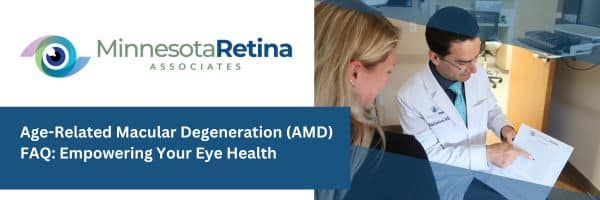
Welcome to our FAQ on Age-Related Macular Degeneration (AMD). At Minnesota Retina Associates, we believe in fostering proactive eye care by providing you with essential knowledge about retinal diseases like AMD. Below, we address common questions surrounding this condition, including risk factors, preventive measures, and treatment options.
Welcome to our FAQ on Age-Related Macular Degeneration (AMD). At Minnesota Retina Associates, we believe in fostering proactive eye care by providing you with essential knowledge about retinal diseases like AMD. Below, we address common questions surrounding this condition, including risk factors, preventive measures, and treatment options.
Q1: What is Age-Related Macular Degeneration (AMD)?
A: AMD is a progressive eye condition that can lead to severe vision loss, impacting the macula – the central part of the retina responsible for sharp and detailed vision. This area allows us to perceive colors accurately and see fine details such as reading and recognizing faces. According to the World Health Organization, AMD is the third leading cause of blindness globally.
There are two types of macular degeneration. Dry AMD is the most common form of AMD, making up about 80% of all AMD patients. Dry AMD occurs when the macula becomes thinner with age, allowing tiny clumps of protein to grow on the macula.
Wet AMD occurs when abnormal blood vessels grow under the retina, and bleed or leak resulting in a decrease in central vision or distortion in the vision. Those with Wet AMD are at risk of losing vision quicker than those with Dry AMD.
Q2: What are the Symptoms of AMD?
A: Symptoms vary based on the type and stage of the disease. While some may not notice any symptoms, others may experience blurriness in central vision or observe distortions, such as straight lines appearing wavy.
Q3: Who is at Risk for AMD?
A: AMD is a leading cause of vision loss among individuals aged 50 and older. The risk of AMD increases with age, and individuals with a family history of AMD are at a higher risk. Lifestyle factors, including poor nutrition, obesity, smoking, high blood pressure, and prolonged exposure to UV light, also contribute to increased risk.
Q4: What Preventive Measures Can Be Taken?
A: While certain risk factors are beyond control, adopting a nutrient-rich diet, protecting your eyes from UV light, avoiding smoking, scheduling regular eye exams, and engaging in physical activity can help reduce the likelihood of developing AMD.
Q5: What Treatment Options Are Available?
A: At Minnesota Retina Associates, our specialists will determine what treatment options are best, depending on the stage and type of the disease. For patients with dry AMD, some may benefit from using specific vitamins and minerals (AREDS 2 formulation supplements) that can help slow the progression of the disease in some stages. Although there is currently no cure for AMD, the FDA recently approved an injection for patients affected by Geographic Atrophy (GA), a form of advanced dry AMD. The goal of this medication is to slow down the atrophy, delaying the loss of vision.
For patients with wet AMD, a standard treatment is the use of anti-VEGF medications. These medications are injected into the eye to slow down leaking and to reduce abnormal blood vessels, ultimately halting or slowing down the progression of vision loss. Another potential treatment option for Wet AMD patients is laser therapy. This treatment aims to seal off the leaking blood vessels at the back of the eye, and to stop them from growing.
At Minnesota Retina Associates, our specialists tailor care and treatment plans to your unique needs. If you have further questions or would like to discuss your retina health, don’t hesitate to reach out to us. We are dedicated to supporting you on your journey to optimal vision.








